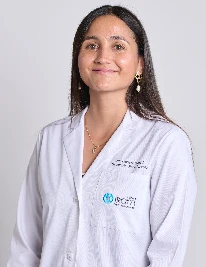Main Session

Sep
29
PQA 05 - Breast Cancer, International/Global Oncology
2980 - Patient-Reported Satisfaction and Cosmetic Outcomes with Ultrahypofractionated Radiation Therapy to the Breast/Chest Wall and Regional Nodes in Latin America
Presenter(s)

Javiera Silva, MD - Clinica IRAM, Santiago, Region Met
J. Silva1, M. Russo2, C. Aranda3, and V. Ovalle4,5; 1Universidad Diego Portales - Clinica IRAM, Santiago, Chile, 2Fundacion Arturo Lopez Perez, Santiago, Chile, 3Pontificia Universidad Catolica de Chile, Santiago, Region Met, Chile, 4Instituto de Radiomedicina IRAM, Santiago, Chile, 5Universidad Diego Portales - Clínica IRAM, Santiago, Chile
Purpose/Objective(s):
Since the pandemic, ultrahypofractionated radiation therapy (RT) has been widely adopted. Following the Nodal Fast Forward results at ESTRO, data on regional node treatment has increased. This study evaluates patient-reported satisfaction and cosmetic outcomes with ultrahypofractionated RT to regional nodes, with or without a simultaneous integrated boost (SIB).
Materials/Methods:
A retrospective review of breast cancer patients treated with ultrahypofractionated RT (26 Gy in 5 fractions) to the breast/chest wall and regional nodes at an academic center in Chile (May/22–Dec./23) was conducted. Patient, tumor, and treatment data were collected. QoL and satisfaction were assessed using BREAST-Q (Physical, Psychosocial, Sexual Well-Being, and Adverse Effects of RT), with scores (0–100). Higher scores indicating better outcomes. Cosmetic outcomes were evaluated using the Harvard Scale. Univariate and multivariate ordinal logistic regression analyses identified predictors of cosmetic results.
Results:
330 patients were treated. Median was age 62 yo; 113 received post-mastectomy RT (PMRT) and 217 had RT to the breast, with 75% of the latter receiving a 4 Gy SIB. Data on 155 patients that agreed to participate are analyzed below. Few RT-related adverse effects were reported (median score: 7; 6 indicating no adverse effects). Fifty-three patients (34%) reported not being bothered by any RT-related effects. SIB was not associated with increased RT toxicity. Median scores for psychosocial, sexual, and physical well-being were 80, 62, and 52, respectively. Cosmetic outcomes were excellent/good in 116 (75%), fair in 26 (17%), and poor in 13 (8%) patients. On univariate analysis, older age, breast-conserving therapy (BCT), and sentinel lymph node dissection were linked to better cosmetic outcomes, with older age and BCT remaining significant in multivariate analysis. Mastectomy significantly reduced the odds of good cosmetic outcomes (OR 0.206, p<0.01), while older age improved them (OR 1.06 per year, p<0.01). Among BCT patients, SIB was associated with worse cosmetic outcomes (OR 0.255, p=0.023). During follow-up, there were only 2 local recurrences, 3 locoregional recurrences, and 4 distant metastases.Conclusion:
Ultrahypofractionated RT to the breast/chest wall and regional nodes was safe, well tolerated, and associated with low late toxicity at 18 months. Most patients reported minimal adverse effects and favorable cosmetic outcomes. However, tumor bed boosts worsened cosmesis in BCT patients and should be carefully selected. Longer follow-up is required to assess recurrence and survival outcomes.